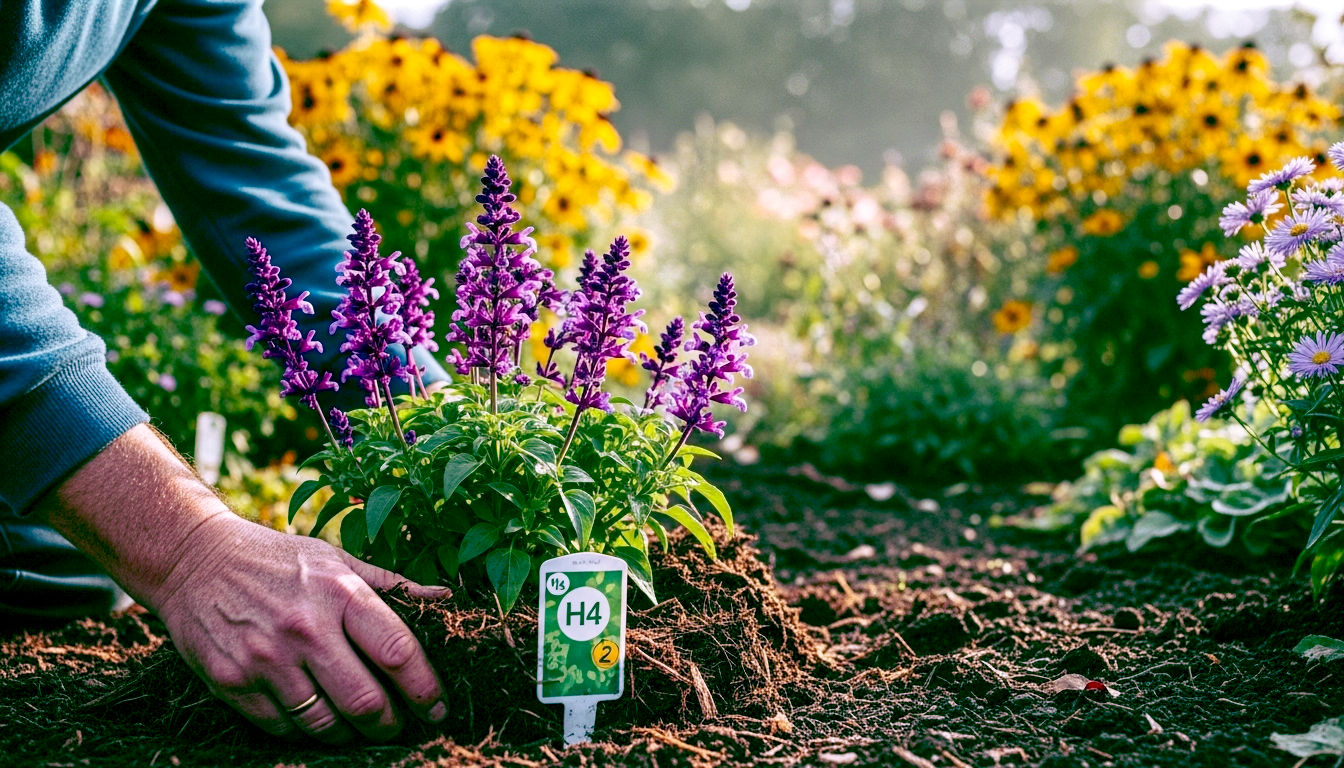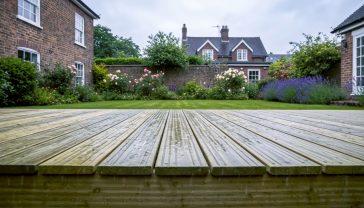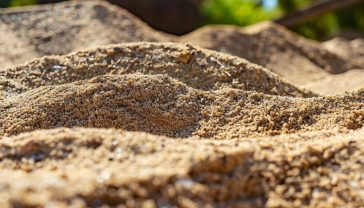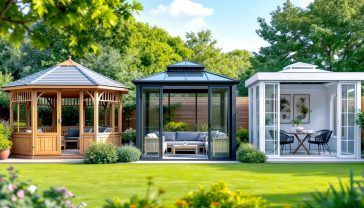The UK Gardener’s Guide to Plant Hardiness Zones: Beyond USDA
Confused by plant hardiness? This ultimate guide explains the UK’s RHS rating system—the British equivalent of USDA zones—and how to use it to build a thriving garden.

This post may contain affiliate links. If you make a purchase through these links, we may earn a commission at no additional cost to you.
Ever bought a beautiful, exotic-looking plant on a whim, only to watch it wither and die after the first frost? You’re not alone. It’s a sad story every British gardener knows all too well. We see a stunning plant in a glossy magazine or on a holiday abroad, and we think, “I’ll have that in my back garden.” But our notoriously fickle weather often has other ideas.
You might have heard American gardeners talking about something called ‘USDA zones’. It sounds very official, very scientific. And it is. It’s a map that tells them exactly which plants can survive the winter in their specific part of the country. It’s a brilliant system that stops them from planting a sun-loving palm tree in the middle of a snowy Alaskan winter.
But what about us here in the UK? We don’t have USDA zones. So, what do we use? Is there a secret map for British gardens that tells us whether that lovely olive tree from the garden centre will actually make it through a wet, cold winter in Manchester?
The short answer is yes, we do have a system. It’s run by the Royal Horticultural Society (RHS), and it’s a bit different from the American one. It’s designed specifically for our unique island climate—the one that gives us drizzly Tuesday mornings but also glorious, sunny afternoons. Understanding it is the key to unlocking your garden’s true potential. It’s the difference between a garden that merely survives and one that truly thrives.
This guide will explain everything. We’ll break down what plant hardiness really means, explore the brilliant RHS system, and show you how to use it to choose the perfect plants for your patch of green, no matter where you are in the UK. Get ready to say goodbye to frosty failures and hello to a garden that works with our weather, not against it.
What on Earth is Plant Hardiness? And Why Should You Care?
Before we dive into maps and ratings, let’s get one thing straight: what does ‘hardiness’ actually mean?
In simple terms, plant hardiness is a plant’s ability to survive cold winter temperatures. Think of it as a plant’s built-in antifreeze. Some plants, like the tough Scots Pine that grows in the chilly Scottish Highlands, are incredibly hardy. They can handle deep freezes and biting winds without batting a leaf. Others, like a delicate fuchsia or a vibrant bougainvillaea, will curl up and die at the first hint of a proper frost.
This is where it gets personal for British gardeners. Our weather is, to put it mildly, complicated. We’re a small island, but our climate is incredibly varied. A garden in coastal Cornwall has a totally different experience of winter to one in the Yorkshire Dales or the heart of London.
That’s why understanding hardiness is so crucial. It’s about making smart choices. It stops you from spending your hard-earned cash on a plant that is doomed from the start. It’s about knowing that the beautiful tree you’re planting won’t just be a temporary feature but a friend for years to come. It’s the secret to creating a garden that feels established, healthy, and happy.
The Famous American System: A Quick Look at USDA Zones
To understand our own system, it helps to know a bit about the one that started it all: the United States Department of Agriculture (USDA) Plant Hardiness Zone Map.
First published in 1960 and updated several times since, the USDA map is the go-to guide for millions of American gardeners. It carves the entire country, from the sun-baked deserts of Arizona to the icy plains of North Dakota, into 13 numbered zones.
Here’s how it works:
- Each zone represents a 10-degree Fahrenheit (about 5.6°C) range of average annual minimum winter temperatures.
- Zone 1 is the absolute coldest (think Arctic conditions), while Zone 13 is the warmest (tropical heat).
- Each zone is also split into two ‘half-zones’, labelled ‘a’ and ‘b’, for extra precision.
So, if a plant is labelled as ‘hardy to USDA Zone 5’, it means it can reliably survive winter temperatures that dip as low as -20°F (-29°C).
It’s a clear, straightforward system. But it has one big limitation, especially for us in the UK: it only measures cold. It doesn’t tell you anything about summer heat, rainfall, humidity, soil type, or wind. And in the UK, those other factors are just as important, if not more so. Our winters are often more wet than they are freezing, and that’s a challenge that the USDA system simply doesn’t account for.
That’s why we needed our own way of doing things.
The British Answer: The RHS Hardiness Rating System
Enter the Royal Horticultural Society. For over 200 years, the RHS has been the guiding star for British gardeners. They know our soil, our weather, and our plants better than anyone. So, it makes sense that they created a hardiness system designed perfectly for the UK.
Instead of zones on a map, the RHS uses a rating scale. It’s a bit like the energy efficiency ratings you see on a fridge or a television. Each plant is given a ‘H’ number, from H1a to H7. This number tells you exactly what kind of winter conditions it can handle.
The beauty of the RHS system is that it considers more than just the absolute lowest temperature. It takes into account the unique challenges of a British winter: frost, wet soil, and chilly winds. It’s a more rounded, practical guide for our specific climate.
Let’s break down the ratings.
Decoding the RHS Ratings: From Tropical to Tough as Old Boots
The RHS scale is simple once you get the hang of it. It’s split into three main groups: tender, half-hardy, and fully hardy.
The Tender Plants: Lovers of the Great Indoors (H1a, H1b, H1c)
These are the sunbathers of the plant world. They can’t stand the cold and need to be kept warm all year round.
- H1a (Higher than 15°C): This is the rating for true tropical plants. Think of the steamy, humid glasshouses at Kew Gardens. These plants need to be kept in a heated conservatory or as houseplants in a warm room. An orchid is a classic example.
- H1b (10°C to 15°C): These plants can handle slightly cooler conditions but still need to be indoors over winter. They’re happy in a conservatory that might get a bit chilly at night. Many popular houseplants, like the Swiss Cheese Plant (Monstera deliciosa), fall into this category.
- H1c (5°C to 10°C): These are tougher but still need protection. They can survive in an unheated conservatory or a frost-free porch over winter. Citrus trees, like lemons and oranges, are often rated H1c.
The Half-Hardy Plants: A Little Winter Protection Needed (H2, H3)
These plants can handle a little bit of cold, but they won’t survive a proper British winter outdoors without some help.
- H2 (1°C to 5°C): This is the rating for what we often call ‘half-hardy’ plants. They can take a very light, brief frost but will be killed by anything more severe. They are perfect for summer bedding schemes but need to be brought into a frost-free place (like a shed or greenhouse) over winter. Common examples include Pelargoniums (often called geraniums) and Fuchsias.
- H3 (-5°C to 1°C): These plants are a bit tougher. In milder parts of the UK, like coastal Cornwall or central London, they might survive the winter outdoors in a sheltered spot with a good layer of mulch. In colder areas, they’ll need to be brought inside or be very well protected. Many agapanthus and some Mediterranean herbs like rosemary fit here.
The Hardy Heroes: Built for British Winters (H4, H5, H6, H7)
These are the plants that form the backbone of most British gardens. They can be left outside all year round without any fuss.
- H4 (-10°C to -5°C): This is the baseline for a hardy plant in most of the UK. If a plant is rated H4, you can be pretty confident it will survive an average winter in most parts of the country. A huge number of popular garden plants, like lavender, penstemons, and hebes, are H4.
- H5 (-15°C to -10°C): These are very tough plants. They can handle severe frosts and will be happy pretty much anywhere in the UK, except for the very coldest, most exposed spots. Most roses, magnolias, and hydrangeas are H5.
- H6 (-20°C to -15°C): Now we’re talking seriously tough. These plants can survive the kind of bitter winters you might get in the Scottish Highlands or the Pennines. They are completely reliable. Many familiar trees like oak and beech, and tough shrubs like holly, would be rated H6.
- H7 (Colder than -20°C): These are the ultimate survivors. They are plants that originate from the coldest parts of the world, like Siberia or the high Alps. They are completely bomb-proof and will survive anything a British winter can throw at them. Think of plants like the Siberian dogwood (Cornus alba ‘Sibirica’) or many tough little alpine flowers.
Here’s a simple table to sum it all up:
| RHS Rating | Temperature Range | Description | Common Examples |
|---|---|---|---|
| H1a | > 15°C | Heated Glasshouse (Tropical) | Orchids, Caladiums |
| H1b | 10°C to 15°C | Heated Glasshouse (Subtropical) | Monstera deliciosa, many foliage houseplants |
| H1c | 5°C to 10°C | Unheated Glasshouse/Indoor | Citrus trees, Bougainvillaea |
| H2 | 1°C to 5°C | Tender (Frost-free) | Pelargoniums, Fuchsias, Begonias |
| H3 | -5°C to 1°C | Half-hardy | Agapanthus, some Salvias, tender Rosemary |
| H4 | -10°C to -5°C | Hardy in most of UK | Lavender, Penstemons, Hebes, most perennials |
| H5 | -15°C to -10°C | Very Hardy | Roses, Magnolias, Hydrangeas, most shrubs |
| H6 | -20°C to -15°C | Extremely Hardy | Oak trees, Holly, many conifers |
| H7 | < -20°C | Ultra Hardy (Bomb-proof) | Siberian Dogwood, many alpine plants |
How Do the RHS and USDA Systems Compare?
So, you’ve found a plant online from an American website, and it says it’s ‘USDA Zone 8’. What does that mean for your garden in Birmingham?
It’s tricky to do a direct, perfect translation because the two systems measure slightly different things. The USDA map is all about that one single data point: the coldest night of the year. The RHS system is more of a general assessment of a plant’s winter toughness in our damp, maritime climate.
However, we can make a rough comparison. It’s not perfect, but it’s a helpful starting point.
- USDA Zone 9 (Minimum -6.7°C to -1.1°C): This is roughly equivalent to our RHS H3 rating. Plants in this zone need a mild winter and a sheltered spot. This matches the climate of places like coastal Cornwall, the Isles of Scilly, and central London.
- USDA Zone 8 (Minimum -12.2°C to -6.7°C): This is a good match for RHS H4. This is the hardiness level needed for most of England, Wales, and lowland Scotland.
- USDA Zone 7 (Minimum -17.8°C to -12.2°C): This lines up pretty well with RHS H5. These are very tough plants that will be happy almost anywhere in the UK.
- USDA Zone 6 (Minimum -23.3°C to -17.8°C): This is getting into RHS H6 territory. These plants are for the coldest parts of the UK, like the Scottish Highlands.
- USDA Zone 5 (Minimum -28.9°C to -23.3°C): This aligns with RHS H7. These are the toughest of the tough.
Why isn’t it a perfect match? The key difference is summer heat. Many plants that are happy in USDA Zone 8 in America, for example in Seattle, need hot summers to ripen their wood and produce flowers. Even though our winter temperatures might be similar, our summers are often much cooler and cloudier. This means a plant that thrives in Seattle might struggle to flower in Sheffield, even if it survives the winter.
This is a really important point. A plant needs to be happy in your garden all year round, not just in December.
It’s Not Just About the Cold: Other Factors That Matter in a UK Garden
The RHS rating is a brilliant tool, but it’s not the whole story. A plant’s survival depends on a whole host of local conditions. This is what gardeners call ‘microclimate’—the unique climate of your specific garden, or even a specific corner of your garden.
Think about it. A plant tucked against a sunny, south-facing brick wall will have a much cosier winter than one shivering in an exposed, windy corner at the bottom of the garden.
Here are the key things to consider beyond the H-rating:
1. The Great British Wet
If there’s one thing our climate has in abundance, it’s rain. And for many plants, cold, wet soil is a bigger killer than cold, dry air. When soil is waterlogged in winter, plant roots can’t breathe. They essentially drown and then rot.
Many plants that come from Mediterranean climates (like lavender and rosemary) or mountainous regions (like alpines) are used to sharp drainage. They can handle the cold, but they absolutely hate having ‘wet feet’.
What you can do: Improve your soil drainage! Adding plenty of grit and organic matter (like well-rotted compost) to your soil will help water drain away more quickly. For plants that are really fussy, consider planting them in raised beds or pots.
2. Wind: The Unseen Enemy
We live on a windy island. Wind has a massive impact on plants. It dries them out, it can physically damage them, and it dramatically increases the effect of cold—this is called wind chill. A temperature of -2°C can feel like -8°C to a plant in a strong, cold wind.
What you can do: Create shelter. Planting hedges, putting up fences, or even strategically placing a few tough shrubs can create calm, sheltered pockets in your garden where more delicate plants can thrive.
3. Aspect: The Power of the Sun
The direction your garden faces makes a huge difference.
- South-facing: This is the dream ticket. A south-facing garden gets the most sun and warmth all day long. It warms up quickly in spring and stays warmer for longer in autumn. A south-facing wall can act like a giant storage heater, absorbing the sun’s heat during the day and radiating it back at night, protecting the plants growing against it. This is where you can try growing things that are a little bit borderline for your area, like figs or grapevines.
- West-facing: Gets sun in the afternoon and evening. It’s still a great spot for many plants.
- East-facing: Gets the morning sun. The big danger here is that plants can be thawed out too quickly by the morning sun after a hard frost, which can damage their cells.
- North-facing: This is the coldest, shadiest part of the garden. But don’t despair! It’s the perfect place for a whole range of beautiful shade-loving plants, like ferns, hostas, and hellebores.
4. Soil Type
The type of soil you have is fundamental.
- Sandy soil: Drains very quickly and warms up fast in spring. This is great for drainage but means it can dry out in summer and doesn’t hold onto nutrients well.
- Clay soil: Is very fertile but can be heavy, sticky, and slow to warm up. It’s prone to becoming waterlogged in winter and baking hard as concrete in summer.
- Loam: The holy grail for gardeners! It’s a perfect mix of sand, clay, and silt. It holds moisture without getting waterlogged and is full of nutrients.
Knowing your soil type is key. You can either choose plants that are naturally happy in your type of soil, or you can work to improve it over time by adding lots of organic matter.
A Tour of the UK: Hardiness in Your Region
The UK’s climate is a glorious patchwork quilt. Let’s take a quick tour to see how hardiness plays out in different parts of the country.
- The South-West (Cornwall, Devon): This is the mildest part of the UK, often called the ‘Cornish Riviera’. Thanks to the warming effect of the Gulf Stream, severe frosts are rare. Gardeners here can grow a huge range of exotic, tender plants that wouldn’t stand a chance elsewhere. You’ll see palm trees, giant echiums, and lush tree ferns thriving. The main challenge here is often wind and salt spray near the coast. Typical RHS rating: H3 plants may survive in sheltered spots; H4 is very safe.
- The South-East (London, Kent, Sussex): This region benefits from the ‘urban heat island’ effect, especially in London, where the mass of buildings and people keeps temperatures several degrees warmer than the surrounding countryside. This creates a fantastic microclimate for growing borderline hardy plants. Summers are also the warmest in the UK, which helps ripen wood for winter. Typical RHS rating: H4 is standard; H3 is possible in sheltered urban gardens.
- East Anglia (Norfolk, Suffolk, Cambridgeshire): This is one of the driest parts of the country. But it’s also flat and exposed to cold winds coming in from the continent. Winters can be surprisingly cold and frosty, despite the low altitude. Typical RHS rating: H4 is generally safe, but H5 is a better bet for exposed sites.
- The Midlands and Central England: This is a real mixed bag. Winters are generally cooler than in the south. Frost pockets—low-lying areas where cold air gathers—can be a real issue. You need to be a bit more cautious here. Typical RHS rating: Stick to H4 and H5 for the backbone of your garden.
- Wales and the North-West: The climate here is heavily influenced by the Atlantic. It’s mild but also very wet and windy, especially in the hills. Good drainage is absolutely essential. The coastal areas are milder, but the mountains of Snowdonia are a different world entirely. Typical RHS rating: H4 is fine, but H5 plants will be more resilient.
- The North-East and Yorkshire: This region gets a double whammy of cold from the north and from across the North Sea. Winters are colder and longer than in the south. Toughness is key. Typical RHS rating: H5 is a very safe choice. Be careful with H4 plants in exposed spots.
- Scotland: Scotland has some of the most varied climate in the UK. The western coast, warmed by the Gulf Stream, is incredibly mild, allowing subtropical gardens like Logan Botanic Garden to flourish. But as soon as you go inland and uphill, it gets cold very quickly. The Highlands and the Cairngorms experience truly arctic conditions in winter. Typical RHS rating: Ranges from H4 on the west coast to H6/H7 in the mountains. For most Scottish gardens, H5 is a reliable choice.
Climate Change: Is Everything Getting Warmer?
You can’t talk about weather without talking about climate change. Our winters are, on average, getting milder. The data clearly shows this. This might sound like great news for gardeners—and in some ways, it is. We can now experiment with plants that would have been unthinkable 50 years ago. Olives, pomegranates, and agapanthus are becoming common sights in gardens far beyond the south coast.
But it’s not that simple. Climate change is also making our weather more extreme and unpredictable.
- We might have a run of very mild winters, which encourages plants to start growing early, only for them to be hit by a sudden, late frost in April or May. This can be devastating.
- We’re also seeing more extreme rainfall events, leading to waterlogging, and longer, hotter summer droughts.
So, while the goalposts are shifting, choosing tough, resilient plants is more important than ever. Hardiness isn’t just about cold anymore; it’s about resilience to whatever weird weather gets thrown at us.
Putting It All Together: Your Practical Hardiness Checklist
Okay, that was a lot of information. So how do you use it? Here’s a simple, step-by-step guide to choosing the right plants for your garden.
- Know Your Rating: When you’re at the garden centre or browsing online, the first thing to look for is the RHS Hardiness Rating. Most reputable nurseries and retailers now include it on their plant labels or descriptions. If a plant is labelled H4 or above, you can be fairly confident. If it’s H3, you need to think carefully. If it’s H2, you know it needs winter protection.
- Assess Your Microclimate: Take an honest look at your own garden. Is it a sheltered sun trap or a windy, north-facing slope? Be realistic about the conditions you have. Don’t try to fight them—work with them.
- Check Your Soil: Dig a hole. Is the soil heavy clay or light sand? Does water sit there in a puddle after it rains? If you have poor drainage, either fix it or choose plants that don’t mind wet conditions (like dogwoods, willows, or irises).
- Think in Layers: The best way to protect plants is to create shelter. Hedges, fences, and walls are your first line of defence. Taller, tougher shrubs and trees can then create sheltered spots for more delicate things to grow underneath.
- The Right Plant in the Right Place: This is the oldest rule in gardening, and it’s still the best. Don’t try to force a sun-loving Mediterranean plant into a shady, damp corner. It will be miserable. Match the plant to the conditions, and it will reward you.
- Don’t Be Afraid to Experiment (A Little!): Once you’ve got the basics right, have some fun! Why not try one or two slightly less hardy plants (H3) in your most sheltered, sunny spot? Put them against a south-facing wall, give them a thick winter mulch, and see what happens. The worst that can happen is you lose a plant. The best is you discover you can grow something amazing.
Gardening in the UK will always be a dance with the weather. We can’t control it. But by understanding hardiness and the unique conditions of our own patch, we can choose the right dance partners. The RHS Hardiness Rating is our best guide in that dance. It’s the tool that empowers us to create beautiful, resilient gardens that can handle a bit of drizzle, a surprise frost, and still burst into glorious life when the sun finally shines.
Further Reading & Resources
For those looking to dive even deeper, these resources are the gold standard for gardening information in the UK:
- The Royal Horticultural Society (RHS): The definitive source for all things gardening, including detailed information on their hardiness ratings. https://www.rhs.org.uk/
- Gardeners’ World: The BBC’s flagship gardening programme and magazine, full of practical, seasonal advice for UK gardeners. https://www.gardenersworld.com/
- The Met Office: For detailed, up-to-date weather and climate information specific to your area of the UK. https://www.metoffice.gov.uk/
- Plantlife: A British conservation charity working to save threatened wild flowers, plants and fungi. A great resource for understanding native British flora. https://www.plantlife.org.uk/uk






